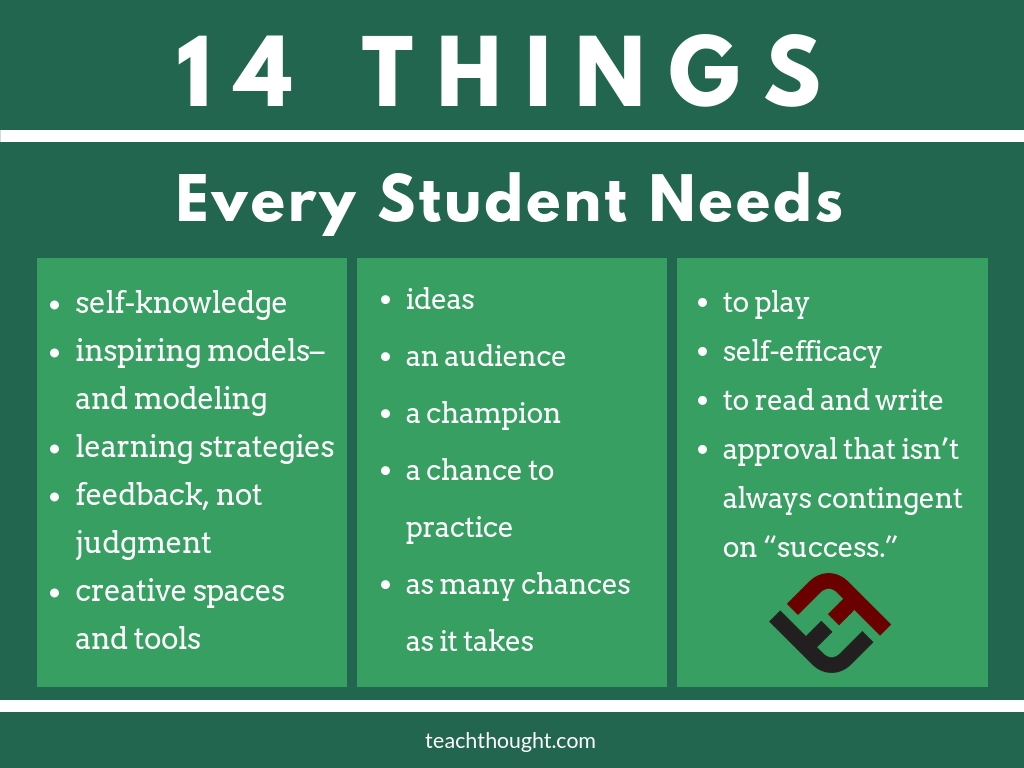 What Every Student Needs
What Every Student Needs
by Terry Heick
There is no perfect lesson, unit, or school any more than there can be a perfect song, flavor, or shade of blue.
Every student is different. Every single intelligent, forgetful, smiling, moody, enthusiastic, apathetic, reflective, short-sighted little (or big) human being that walks into your classroom on a daily basis has their own story–one full of promise, heart-break, and complexity. And this isn’t just rhetoric, it’s true, and it matters.
So when we talk about student-centered classrooms, that too is a kind of generalization–more of an approach than a strategy. There can’t be one ‘student-centered’ reading strategy, for example. Maybe a ‘class-centered,’ but if it’s truly ‘student-centered,’ well then you’d have one for each student, yes?
But what is universal? In our collective effort to design learning experiences, schools, curriculum, technology, and all the other bits of education just right, is it possible that we miss some of the more obvious pieces? Pieces that every single student needs?
See also What Every Teacher Needs
That can be added to everything–curriculum, frameworks, school design, instructional strategies, and anything else that touches the mind of students?
What does every single student need–absolutely, positively have to have–to succeed inside and outside of the classroom?
14 Things Every Student Needs
1. Every student needs self-knowledge.
Who am I and how do I relate to the world around me? What is required of me? How can I provide value to those memberships I value? Where have I been, and where am I going?
And part of a sense of self is a sense of place–the places and communities the student is embedded within and chooses for themselves.
2. Every student needs inspiring models–and modeling.
Models offer ideas, can act as scaffolding, illuminate possibility, provide a pathway, and give students something to anchor their thinking to when everything else seems abstract and academic. The more creative, authentic, inspiring, and diverse, the better the chance every student can be reached.
Modeling–showing how, when, where, and most importantly why–matters too, bringing lessons from ideas to action.
3. Every student needs to know how to learn.
Every student needs to know how to learn–learning strategies. And they need to know those strategies as well or better than the content.
And they need ones that make sense to them. That they understand and can grow into. Don’t tell them to ‘use analogies’ because ‘research’ says so. They need smart, intelligent, useful, flexible learning strategies that they can–and will–use unprompted because they know they need them. How to take notes–how to take Cornell Notes, for example. How to ask and then refine questions. How to research and document their findings.
And part of this is both the ability and tendency to think critically.
4. Every student needs feedback.
Feedback helps–acts as guidance. It’s corrective and can even be comforting.
Judgment is personal and emotional–and hurts.
You won’t always get this part perfect, but if you can at least try to hear yourself and know the difference, you’re better of than you would be otherwise. We often can’t tell how our ‘learning feedback‘ sounds no matter how we mean for it to sound.
5. Every student needs creative spaces, tools, and opportunities.
This could be physical or digital, alone or in a group, with apps or saws, robotics or paintbrushes, maker learning or academic, self-directed, or outcomes-based. Creativity isn’t something that’s added on–it’s an honoring of a basic human need for self-expression and self-direction.
6. Every student needs ideas (or the chance to share their own).
See #1. Students are infinitely more clever than the design of most schools and curriculum seems to suggest they are, but they’re still growing, with widely varying backgrounds of knowledge and schema. Sometimes they need ideas–and that’s all they need: an idea, and for you to get out of the way.
7. Every student needs a sense of purpose.
If no one is really, truly listening–barring exceptional natural ambition–why bother? Every student needs a purpose–a reason to do what they do. Whether you think of it as student engagement or in terms of intrinsic and extrinsic motivation, students need some kind of will, reason, goal, or sense of purpose.
8. Every student needs a champion.
Every student needs to believe in themselves, of course. But not all do. Students need a champion–someone to believe in them when their own conviction falters.
9. Every student needs a chance to practice.
And not only practice, but with a variety of support (none, a little, and a lot), with a variety of collaborators, with and without technology, with and without an audience, with and without prescription and instruction, and both ends–but still within–their Zone of Proximal Development.
10. Every student deserves as many chances as it takes.
Because what else are you going to do? Tell them this is real life and that they’ve used all of their chances? That they should’ve listened the first 12 times? That you’re done with them?
11. Every student needs to play.
Not at recess–with ideas. With possibilities. With (or in) nature. With collaboration partners. With apps. With digital media. With networks. With their own thinking. With approaches. With maker learning materials. By tinkering and testing and failing forward. With models and challenges and games and joy.
12. Every student needs a sense of agency and choice.
This one’s a bit of a bugger because it’s not a teacher action but an outcome from a bunch of stuff you may have nothing to do with. But without the belief they can–which often is preceded by complicated notions of self-worth–everything else is less.
13. Every student needs to be able to read and write.
And it’d be fair to say read and write exceptionally. No, they all won’t be professors or lawyers, but literacy struggles can be a lifetime struggle and many they’ll form all kinds of painful and often damaging self-defense mechanisms to protect it.
Literacy is the foundation for all formal and academic learning.
14. Every student needs hope.
Every student needs hope–a sense that they have a future and some degree of agency and affection in choosing how that future might work out.
Image attribution flickr user globalpartnershipforeducation; What Every Student Needs
